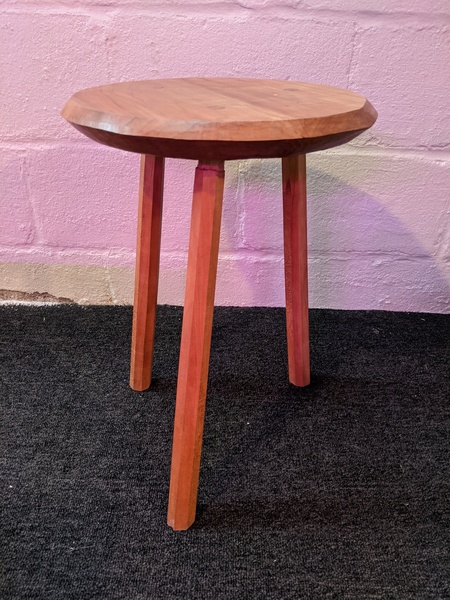|
Bloody posted:I drilled some angled holes for a staked sawbench and two of the four are at least kinda close to the correct angle. this bench is gonna look drunk as hell and I'm stoked Elder Postsman posted:Are they as bad as this post ur hosed up leg angles 
|
|
|
|

|
| # ? May 30, 2024 16:01 |
|
I just recently upgraded my big box buck bros block plane to a LN low angle adjustable mouth block plane and yeah now it's probably the nicest tool I own. Unfortunately now I want more of their very expensive hand tools. I get the most use out of a block plane to pare down parts and trim, but if you are going to be using it on lumber or for smoothing I'd go with a jack plane (stanley #5). Those staked stools rule. Makes me want to make a funky one myself.
|
|
|
|
TooMuchAbstraction posted:That basic concept makes sense to me. The one thing that strikes me as concerning is that it looks like those two center boards are attached to the rest of the base with screws only. They could work loose over time. I'd advise adding some blocking going crosswise, to help resist that kind of force. fair point. I was mostly just napkin-scratching how the tenon would be held in place. I think I might add a cross one, and connect some of the pieces with rabbets and dadoes. BTW Kaiser Schnitzel - the log was quite a bit wetter inside than I hoped, but not as wet as I feared. Overall it was dry enough to split with a chisel but we enough that it was binding my saws. I'm going to let it air out for a time before I do anything else to it.
|
|
|
|
Kaiser Schnitzel posted:What you have is a spring joint which is great for edge glue joints because one clamp in the middle with pull the whole joint tight, but bad for cauls. In a jointer, this is usually caused by the tables (in your case the two sides of the fence) not being exactly parallel. Leperflesh posted:If all you want is something to occasionally throw a bevel along a corner, scrape a sixteenth off of a short plank edge, gently round a board, etc., a cheap fuckin $20 home depo plane will be fine. GEMorris posted:Anyhow, if someone had no power jointer or planer, I'd definitely say no6 first
|
|
|
|
I own a no. 4, a no. 5, don't have a powered jointer. Talk me out of the veritas low angle jack to be my jointer and shooter.
|
|
|
|
Probably the laziest possible way to do splines...but it seems to work?
|
|
|
|
I managed to find a decent shape stanley 9 1/4 the other week and I already can't imagine life without it.
|
|
|
|
Bouillon Rube posted:Probably the laziest possible way to do splines...but it seems to work?  Routers are great for shallow splines.
|
|
|
|
NomNomNom posted:I own a no. 4, a no. 5, don't have a powered jointer. Talk me out of the veritas low angle jack to be my jointer and shooter. The biggest downside to that plan is the fact that the low angle jack is only 15" long, rather than 18", so the length of board that you can reliably and easily flatten is also less (approx 4x the length of the plane) Obv with tons of skill you can true a bed rail with a block plane but it's not easy and it's a ton of work. The other downside would've been that the low angle jack is harder to make work as a coarse fore plane for really hogging off material, but your #5 covers that function. The low angle jack is definitely more suited to the shooting board than the #6. I am not a fan of the 6 on the shooting board for ergonomic reasons and actually use my sbus most of the time for shooting.
|
|
|
|
I've been trying to use my no 4 as a shooter and it works... But it's uncomfortable. Really I just want to splash out on a premium plane and the jack seems like the best fit
|
|
|
|
I've been happy with my low angle jack but it's also my only plane. It seems like it'd be kinda redundant with a no 5
|
|
|
|
Bondematt posted:
Are they supposed to be deeper than that? I thought the rule was half the width of the wood
|
|
|
|
Bloody posted:I've been happy with my low angle jack but it's also my only plane. It seems like it'd be kinda redundant with a no 5 If someone is going for a single-plane setup (usually because they have power tools and are moving towards hybrid, or because they are on a hyper minimalism kick) it is *extremely* hard to argue for anything other than a bevel-up jack.
|
|
|
|
my table saw has developed a new feature where if it is plugged in it is running. I think I'm never gonna use this saw again lmao
|
|
|
|
I just have a Veritas LAJP and a block plane and almost never feel like I need anything else.
|
|
|
|
Bloody posted:my table saw has developed a new feature where if it is plugged in it is running. I think I'm never gonna use this saw again lmao Or never stop using it.
|
|
|
|
Without giving much background, I work with a student who is in desperate need of some hands-on alternatives to regular class work (at risk of dropping out/expulsion on current trajectory). He is a totally different person when he is working with his hands, looks up to his dad who's a tradesman, etc. We had some success with wooden model kits but it's financially unsustainable. I'm thinking about attempting small woodworking projects that we could potentially sell or raffle at the farmers market or on Facebook buy & sell groups, with proceeds reinvested in supplies. The problem is, the school no longer has a shop/shop class, whereas my classroom has very few students and room enough for a workbench and shop vac. What's my shopping list in terms of a basic, unpowered hand tool kit if I wanted to do small projects like stools, birdhouses, maybe a blanket box, small bookcases, etc? I can probably rustle up a good chunk of change in one-time grant funding but safety will be paramount and, for that reason, power tools are off the menu. I know properly sharpened tools will also gently caress you up, but there's a conversation to be had about purchasing a handsaw or chisels, whereas asking to buy a table saw would be a hard no. Or is the idea too silly?
|
|
|
|
just another posted:Without giving much background, I work with a student who is in desperate need of some hands-on alternatives to regular class work (at risk of dropping out/expulsion on current trajectory). I like this idea, if only because it will require you to buy a bit brace 
|
|
|
|
Bloody posted:my table saw has developed a new feature where if it is plugged in it is running. I think I'm never gonna use this saw again lmao Worst-case, you can get an aftermarket switch (the kind with the giant STOP paddle) for 30 bucks.
|
|
|
|
just another posted:Without giving much background, I work with a student who is in desperate need of some hands-on alternatives to regular class work (at risk of dropping out/expulsion on current trajectory). What kind of wooden model kits were you doing that were financially unsustainable? I do wood ships and they take forever to build, so the actual cost is pretty silly low. If you have had success with that, I would assume you/he already have the tools to do them, so I could reach out to the community and probably get you at least a few wooden ship kits for free for a good cause like this.
|
|
|
|
Bloody posted:my table saw has developed a new feature where if it is plugged in it is running. I think I'm never gonna use this saw again lmao Might have dust in the switch. Which next time you unplug it, take the cover off the switch if you can, and even if you can't blast it with air.
|
|
|
|
just another posted:Without giving much background, I work with a student who is in desperate need of some hands-on alternatives to regular class work (at risk of dropping out/expulsion on current trajectory). How old is the student? You mentioned some small woodworking projects like stools, birdhouses, boxes, bookcases. These are a disparate set of projects, though, each asking for some different tools, albeit with overlap. You also mentioned having stuff you could sell at a farmer's market: but I would not expect student work to be sellable, at least not to people looking for quality things. Let me run this a different way, though. In terms of tool sets, and projects that can be done with them? Absolute bare minimum "woodworking" toolset is a whittling knife. With this and only this, a person can make little whittled objects. For all of the next projects, tools in common include straight edge, combination square, measuring tools, marking tools, clamps, glue, and sanding tools (sanding block, sandpaper, etc). Also PPE: dust masks, eye protection, and for any power tool use, ear protection. Finishing with anything other than brushed-on paint implies more tools like rags, ventilation, stirring and cups and maybe some solvents depending on what you're doing, etc. And you need sharpening options for anything that will cut. Ideally saw files for saws, whetstones or a sandpaper-style sharpening setup for chisels or plane blades. Next up I'd say is the birdhouse type project. Small, quality isn't important, wood quality isn't important, the birds don't give a poo poo. This is like the kid making mom an ashtray level of project. For this you need a saw, and either hammers and nails, or screws and a drill. A bench with a vise would be very helpful. To make a stool, it depends on the design. If you want a staked stool as seen in recent photos, you need a way to cut a big hole through something. A power drill is really indispensable here, unless you feel like acquiring a brace and some big augur bits, but that approach requires significantly more skill. A saw is again needed but to cut curves you probably want a coping saw (or a bandsaw) in addition to something good for sawing straight lines, and if you want to turn square pieces of wood into round pieces of wood (think: rounded legs), you'll want something like a spokeshave, draw knife, maybe a coping saw. You'll also want glue, clamps, measuring tools, a straight edge, etc. Chisels would not go amiss here either. To make small boxes, think similar setup as the birdhouse, but more precision is needed. I would say a hand plane becomes essential here. If you want to do things like inset hinges, splines, etc., you need chisels and it'd be good to have a router plane. To make shelves, you're working with larger pieces of wood. You can do pocket holes with a pocket hole jig, or go for more traditional joins. You need a saw, and if you want to do lap joints or something you again want something that can do a rabbet, such as a rabbet plane. You could just go with simple corners and provide structure using a solid back, just tack everything with small nails or screws? Really depends on the quality you're shooting for. You'll definitely need bigger clamps, bigger straight edges, and a bigger benchtop than for the previous projects. I would say some more good smaller projects to work on are cutting boards, serving trays, things like that just require get wood flat, smooth, and do basic glueups. I might have missed something so I hope someone else weighs in.
|
|
|
|
just another posted:Without giving much background, I work with a student who is in desperate need of some hands-on alternatives to regular class work (at risk of dropping out/expulsion on current trajectory). Entirely doable, there's a whole swathe of hobbyists out there dedicated to using nothing but hand tools for the craft, and they make some truly incredible stuff. That said, everything listed above is going to be important to setting up any school shop project, regardless of scale. Oh, and first aid kits on site, and waivers for injury. Pad your timeline/metrics like hell, though, because a chipped chisel is going to take most of a period to fix, and a truly busted anything might mean adjusting reportables while replacements are found.
|
|
|
|
So what tools will be needed for hand tool working. Rip saw Cross cut saw Dovetail saw (I like my veritas) Set of chisels from 1/4 to 1 inch perhaps (and a mallet/hammer) A 4Ĺ size smoothing plane to start with And sharpening equipment for the chisels and blades. Lots of choices on the sharpening front, there's Tormek and clones, or japanese water stones, american oil stones, belt-sander sharpeners like the Sorby ProEdge. Depends on you budget, I think the Tormek style sharpeners work nice and produce a concave profile which is then easy to keep sharp in the right angle with a fine oil or water stone until the next time it needs a new grind. They take longer to fix a chip however than a belt sharpener or similar system would, which produce a flat bevel (one could probably touch that up with a special belt and forego stones alltogether). Perhaps sharpening equipment for the saws (triangular file) and a tool for setting the teeth. Or japanese saws, they last longer but can't be sharpened so you throw them away and buy new ones.
|
|
|
|
Last night I picked up a free dinner table, it was 220x100cm in size and was made in Malaysia. Nothing special but it was broken in one place. Anyway it was 5 minutes away from me so I picked it up and last night I broke it down into components. Everything was pocket hole based so I was able to disassemble it into components. The top, which was the main attraction I want to make into square shelves for my sons bedroom, I can get three box jointed shelves that are 50x50cm in size and 30cm deep from the top. The legs are pretty sturdy too and I bet I will find some use for them. I wonder what kind of wood it's made from, some type of hardwood but that's all I know. I also repurposed some of the planks from the subframe and laminated it into a thicker piece, will come in handy for the pantorouter as a component.
|
|
|
|
Bloody posted:my table saw has developed a new feature where if it is plugged in it is running. I think I'm never gonna use this saw again lmao My table saw also has this feature! I have it attached to a remote controlled outlet (which I unplug when I'm not cutting poo poo with it).
|
|
|
|
I am trying to build a bassinet for our baby that will arrive soon and so far I have the basket part done. I have a question about the physics of swinging.  This is the basket shape I made. I was planning to attach it like they show here but I notice some other designs have the basket hang down a little from the swing point:    I am wondering if there is any advantage/disadvantage to each approach. Its a little hard for me to visualize swinging in my head. Am I over-thinking this? I think my original plan would be the easiest to do, but I could probably do the other ones if it makes a big difference.
|
|
|
|
Better finish that bassinet so you can get started on the crib you'll need a month or two later! Looks great man. Tbh you're probably overthinking the swinging. Hmm now that I'm thinking about it more, having it hanging from something that swings will change the action of the swing quite a bit and make it much smoother I think. Rufio fucked around with this message at 15:28 on Feb 8, 2021 |
|
|
|
There's a guy I watch on youtube, Rex Kreuger, who has a "Woodwork for Humans" series, which is about woodworking with no space and minimal tools. I think at the beginning he goes with a hatchet, a knife, a square, and a japanese pull saw (which is a good buy for a "only one tool" shop, as it has both rip and cross cut teeth on it).
|
|
|
|
His Divine Shadow posted:the pantorouter  Did you make your own? Post it I'm super jealous
|
|
|
|
Do normal people actually try to do rip cuts with Ryoba saws (or any hand saws for that matter)? It seems like it would take forever and be really difficult to keep the line straight considering thst you can get a cheap circular saw with a rip fence for like $50 these days
|
|
|
|
Bouillon Rube posted:Do normal people actually try to do rip cuts with Ryoba saws (or any hand saws for that matter)? It seems like it would take forever and be really difficult to keep the line straight considering thst you can get a cheap circular saw with a rip fence for like $50 these days Jokes aside, rip cuts and surfacing stock are by far the most boring, tedious, physically exhausting parts of hand tool woodworking, but with a sharp saw and a decent bench itís not as slow as youíd think.
|
|
|
|
Bouillon Rube posted:Do normal people actually try to do rip cuts with Ryoba saws (or any hand saws for that matter)? It seems like it would take forever and be really difficult to keep the line straight considering thst you can get a cheap circular saw with a rip fence for like $50 these days I'm a little broke-brained, but I've found plenty of instances where power tools are more hassle than just breaking out a hand saw. Tenons, dovetails on unwieldy pieces, and breaking down small planks all immediately come to mind, and sometimes power tools are just too loving loud. Lots of repeated rips or really long boards get the circular or table saw, but ripping straight with a hand saw isn't terribly difficult with some practice, patience, and the right tooth pattern.
|
|
|
|
For me, using power tools means dragging the boards upstairs and outside (so it also requires tolerable weather) so unless itís a serious hassle, Iím using a hand saw.
|
|
|
|
GEMorris posted:
Ya this is me, so I have something to put my birthday money towards  I have an old Stanley No 4 that was a gift, and I'm slowly working on restoring it. There's not a lot of surface rust, mostly dirt and grime in the frog and poo poo so I'll probably try to brush that off rather than strip it chemically. I have tried to sharpen the iron using Shapton glass stones in 500, 4000, and 8000 grit using a honing jig and digital angle gauge so I know the angle is correct. It feels like the edges of the iron are getting sharp but the middle is still noticeably dull. I got a flattening stone cuz Lee Valley had a sale, but I'm still a bit unsure because I've only used those stones for sharpening kitchen knifes so I don't think they ought to be super cupped yet. We'll see after I give it a try, I've been stuck in quarantine with two kids for 3 weeks and I want to go do something. Later on, since the glass stones are deposited on float glass it seems like I would also be able to use the reverse glass side and just temporarily stick some adhesive sandpaper on it for a truing surface as well, right?
|
|
|
|
Bouillon Rube posted:Do normal people actually try to do rip cuts with Ryoba saws (or any hand saws for that matter)? https://www.youtube.com/watch?v=cTHLpA4267Q&t=73s
|
|
|
|
I've found ryoba saws to be rather clumsy for ripping or resawing. The plate is so thin you can saw in curves, and worse, is so short you're forced to make really short, inefficient strokes. If it's long enough to go through anyway, because as you tilt the board the length of the sawcut increases substantially, making it even worse. (Also, you can't sharpen the drat things because they have hardened teeth, so once they start getting dull it'll only get worse.) A big old 6-7 point 26" Disston I picked up for 25 pounds on eBay is my go-to for these kind of things. Sharpened, properly set, and with a bit of lubrication on the plate it'll go through any stock quickly. Not bandsaw quickly, but not slow either, and nowhere near as difficult as some would like you to believe. Definitely laborious though, but it gets the job done, and when you consider how much a bandsaw that can actually handle resawing 6+" wide & tough wood costs, a far more realistic proposition for the budget and/or space constrained woodworker. (Or if you're a loving weirdo like me, and get a weird sense of enjoyment from doing it like this.)
|
|
|
|
Kaiser Schnitzel posted:Normal people donít, but ColdPie does. Perfectly normal people used handsaws to rip for hundreds of years before the 1960s tyvm. If anything the current usage of power tools is the aberrant behavior 
|
|
|
|
Big Dick Cheney posted:I am wondering if there is any advantage/disadvantage to each approach. Its a little hard for me to visualize swinging in my head. Am I over-thinking this? I think my original plan would be the easiest to do, but I could probably do the other ones if it makes a big difference. If you treat this as a simple pendulum, the further away your center of mass is from the pivot point, the more time the swing will take, independent on the angle of the swing or the weight. I also "feel" like it will be a bit more stable as small shifts in weight will result is smaller changes in angle and/or swing. But this is mostly just going on instinct on my part.
|
|
|
|

|
| # ? May 30, 2024 16:01 |
|
No students today so I can focus on posting  And a generic thank you for everyone's replies. The Locator posted:What kind of wooden model kits were you doing that were financially unsustainable? I do wood ships and they take forever to build, so the actual cost is pretty silly low. If you have had success with that, I would assume you/he already have the tools to do them, so I could reach out to the community and probably get you at least a few wooden ship kits for free for a good cause like this. The project we had the most success with was this: https://kidder.ca/design-build/trebuchet-kits.html ... Which had the bonus incentive of a promise to launch a clay ball at his teacher. But that was right on the borderline of his patience for finicky manual dexterity requirements. That being said, if you know of any that are relatively simple then I'm all-ears. We do have some program funding for things like this, I just can't afford $30 - $50/week for one student in perpetuity. Leperflesh posted:How old is the student? He's 14. And we'd definitely be looking for pitybux. I'm hoping some people might be willing to throw a few dollars our way if they know it was a student project. Worst case scenario, if we can produce concrete things that look somewhat useful, and I can directly connect it to the program's goals, then it'll be easier to justify it to senior admin/the board office/trustees. If I can put together some funding for the initial tool purchase then we can also look into scrap lumber or reclaimed wood from one of the many abandoned properties in the area. The goal right now is to just get this kid working with his hands at as low a cost-per-day as possible. CommonShore posted:There's a guy I watch on youtube, Rex Kreuger, who has a "Woodwork for Humans" series, which is about woodworking with no space and minimal tools. I think at the beginning he goes with a hatchet, a knife, a square, and a japanese pull saw (which is a good buy for a "only one tool" shop, as it has both rip and cross cut teeth on it).
|
|
|










































